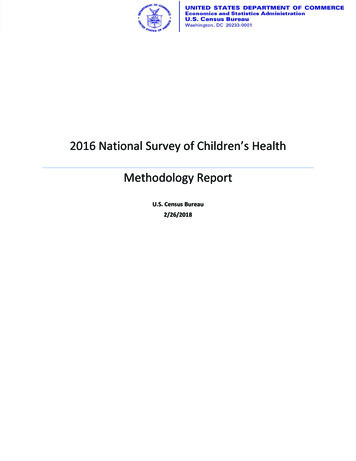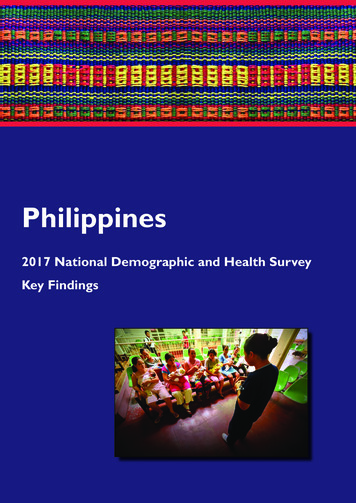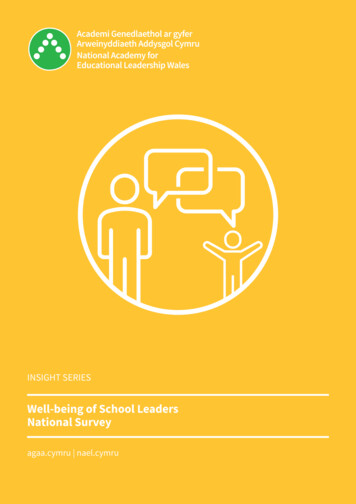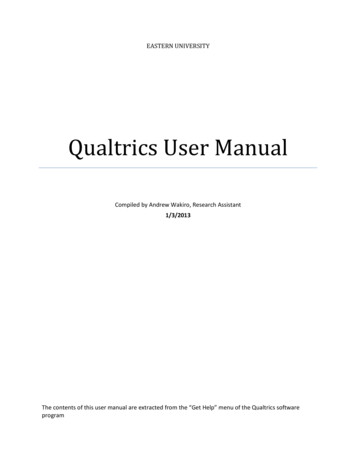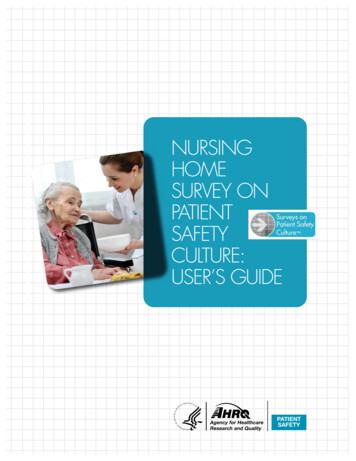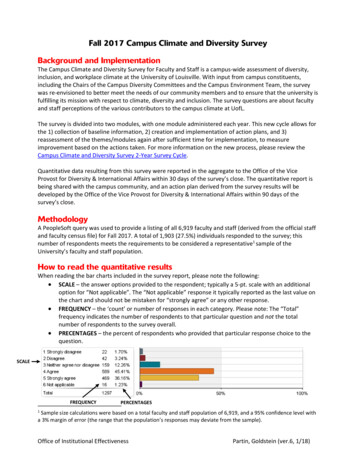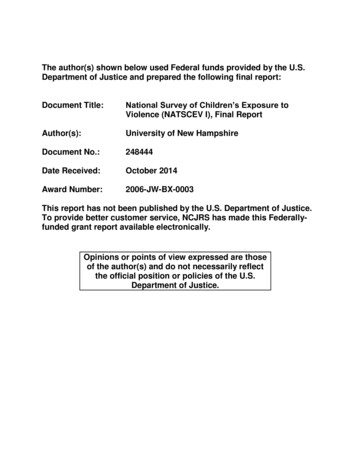
Transcription
The author(s) shown below used Federal funds provided by the U.S.Department of Justice and prepared the following final report:Document Title:National Survey of Children’s Exposure toViolence (NATSCEV I), Final ReportAuthor(s):University of New HampshireDocument No.:248444Date Received:October 2014Award Number:2006-JW-BX-0003This report has not been published by the U.S. Department of Justice.To provide better customer service, NCJRS has made this Federallyfunded grant report available electronically.Opinions or points of view expressed are thoseof the author(s) and do not necessarily reflectthe official position or policies of the U.S.Department of Justice.
NATIONAL SURVEY OF CHILDREN’S EXPOSURE TO VIOLENCE (NATSCEV I)Final ReportENCLOSED1. Appendix A: Peer-reviewed Publications (Note: Appendix A Removed Due to Copyright Restrictions) CV221, Poly-victimization in developmental context.CV225, Specifying type and location of peer victimization in a national sample of children and youth.CV217, Disability and victimization in a national sample of children and youth.CV209-DRAFT, Family context, victimization, and child trauma symptoms: Variations in safe, stable,and nurturing relationships.CV261-DRAFT, Teen dating violence: Co-occurrence with other victimizations in the national surveyof children’s exposure to violence (NatSCEV).CV239-DRAFT, Let's prevent peer victimization, not just bullying.CV235, Family structure, victimization, and child mental health in a nationally representative sample.CV246-DRAFT, Recent victimization exposure and suicide ideation in adolescents.CV249-DRAFT, Poly-victimization as a factor in sexual re-victimization.2. Appendix B: OJJDP Bulletins CV197, Children’s exposure to intimate partner violence and other family violence.CV229, Polyvictimization: Multiple exposures to violence in a national sample of children.CV224, Questions and answers about the National Survey of Children’s Exposure to Violence.CV214B-DRAFT, Child victimizations known to police and other authorities.CV227-DRAFT, Victimization and delinquency in a national sample of youth.1This document is a research report submitted to the U.S. Department of Justice. This report has notbeen published by the Department. Opinions or points of view expressed are those of the author(s)and do not necessarily reflect the official position or policies of the U.S. Department of Justice.
FINAL REPORTNational Survey of Children’s Exposure to Violence (NATSCEV I)Summary of Project. The primary purpose of this project was to conduct a national study todocument the incidence and prevalence of children’s exposure to violence in the United States.We completed a comprehensive assessment of exposure to violence that incorporated a widerange of victimization experiences and that included children across a wide developmentalspectrum. We also measured a variety of potential predictors and outcomes of children’sexposure to violence. Telephone survey methodology was used to obtain a target sample of 4,549children ages 0-17.Goals & Objectives1. Assess event characteristics, including the location of exposure, the severity of the event(e.g., whether injury resulted), the frequency of occurrence across type of exposure, thechild’s relationship to the perpetrator, and, in the case of witnessing, to the victim.2. Document variations in incidence and prevalence exposure across gender, race, socioeconomic status, family structure, region, urban/rural residence, and developmental stageof child.3. Specify how different forms of violent victimization “cluster” or co-occur.4. Identify individual, family, and community-level predictors of violence exposure amongchildren.5. Examine associations between levels/types of violence exposure and child mental healthand delinquency behaviors.6. Assess the extent to which children disclose incidents of violence to various individualsand the nature and source of assistance or treatment (if any) given to the child.MethodologyOctober 2006 to October 2007 was dedicated to planning and survey preparation phases of thestudy. The most important objective in this planning phase was establishing domains of violenceexposure to be included and how they would be measured. In consultation among NATSCEVresearch team, OJJDP project supervisors, and 12 designated study consultants, we developedadditional measures to supplement the Juvenile Victimization Questionnaire (JVQ).We received human subjects approval for NATSCEV from the University of New HampshireInstitutional Review Board (IRB) in June 2007. This involved establishing a protocol forresponding to cases of potential child endangerment revealed in the course of the survey. As partof this protocol, we developed a computer program to flag respondents who are potentially indanger and have included a clinical psychologist on the research team to re-contact respondentthat require follow-up.SCHULMAN, RONCA & BUCUVALAS, INC. (SRBI) were given the subcontract for the datacollection. The principal investigators, David Finkelhor and Heather Turner, have workedextensively with SRBI on this and other surveys.2This document is a research report submitted to the U.S. Department of Justice. This report has notbeen published by the Department. Opinions or points of view expressed are those of the author(s)and do not necessarily reflect the official position or policies of the U.S. Department of Justice.
From October 2007 to December 2007, we finalized the questionnaire, completed CATIprogramming and testing, engaged in extensive interviewer training, and had the questionnairetranslated into Spanish. The questionnaire was also translated into Spanish. We developed anational sampling strategy that included a national RDD cross-section and an over-sample ofAfrican-American, Hispanic, and low socio-economic status respondents.We entered the field in December 2007 and completed the survey in July 2008. The sample sizefor the entire survey is 4,549. We have a sample 3,058 respondents associated with the nationalRDD sample (1,501 age 0-9; 1,552 age 10-17). We obtained 1,496 respondents from our oversample of minority and low-income census tracks (954 age 0-9; 542 age10-17). From July 2008to December 2008 we engaged in data cleaning, scale construction, and sample weighting toadjust for the complex sample design. Since that time we have been actively engaged in dataanalysis and manuscript preparation.In the six months since our last progress report, we have conducted additional analyses, writtenthree manuscripts, and disseminated results at several conferences. In this recent time periods,one article was published, two additional articles are currently in press, and one more is insubmission. NatSCEV findings have been presented at several national professional conferencesand international venues.Final DeliverablesAll objectives have been met and as evidenced within the manuscripts, bulletins andpresentations generated from this study. Peer-reviewed manuscripts using NatSCEV I data,completed within the full project period, are listed below. Also listed are all completed OJJDPBulletins (either published or in press) and all conference presentations given during the projectperiod that contain NatSCEV content. We note that, although the NatSCEV I project period isover and funding expended, we continue to analyze data and anticipate completing additionalmanuscripts using NatSCEV I data.Peer Review Manuscripts (publications with an asterisk have been published and/or added since thelast reporting period – July, 2011. These publications are included in Appendix A).Mitchell, K., Finkelhor, D., Wolak, J., Ybarra, M., & Turner, H. (2011). Youth Internetvictimization in a broader victimization context. Journal of Adolescent Health, 48: 128134.*Finkelhor, D., Shattuck, A., Turner, H.A., & Ormrod, R.K. (2011). Poly-victimization indevelopmental context. Journal of Child & Adolescent Trauma, 4: 291-300.*Turner, H. A., Finkelhor, D, Hamby, S., Shattuck, A. & Ormrod, R. (2011). Specifying typeand location of peer victimization in a national sample of children and youth. Journal ofYouth and Adolescence. 40, 1052-67.*Turner, H.A., Vanderminden, J., Finkelhor, D., Hamby, S. and Ormrod, R. (2011). Disabilityand victimization in a national sample of children and youth. Child Maltreatment. 16,275-86.Turner, H.A., Finkelhor, D. and Ormond, R. (2010). Poly-victimization in a national sample ofchildren and youth. American Journal of Preventative Medicine. 38(3): 323-330.3This document is a research report submitted to the U.S. Department of Justice. This report has notbeen published by the Department. Opinions or points of view expressed are those of the author(s)and do not necessarily reflect the official position or policies of the U.S. Department of Justice.
Finkelhor, D., Turner, H.A., Ormrod, R. and Hamby, S. (2010). Trends in childhood violenceand abuse exposure: evidence from two national surveys. Archives of Pediatric andAdolescent Medicine, 164(3):238-242.Turner, H.A., Finkelhor, D., Ormond, R. and Hamby, S. (2010). Infant victimization in anationally representative sample. Pediatrics, 126(1): 44-52.Hamby, S., Finkelhor, D., Turner, H.A., and Ormrod, R. (2010). The overlap of witnessingpartner violence with child maltreatment and other victimizations in a nationallyrepresentative survey of youth. Child Abuse and Neglect.Finkelhor, D., Ormrod, R., Turner, H.A. and Hamby, S. (2010). Abuse and victimization knownto school, police and medical officials in a national sample of children and youth.Archives of Pediatric and Adolescent Medicine.Finkelhor, D., Turner, H.A., Ormrod, R. and Hamby, S. (2009). Violence, abuse, and crimeexposure in a national sample of children and youth. Pediatrics 124(5):1411-23.*Turner, H.A., Finkelhor, D., Ormond, R., Hamby, S., Leeb, R., Mercy, J. and Holt, M. (inpress). Family context, victimization, and child trauma symptoms: Variations in safe,stable, and nurturing relationships. American Journal of Orthopsychiatry.*Hamby, S., Finkelhor, D., & Turner, H. (in press). Teen dating violence: Co-occurrence withother victimizations in the national survey of children’s exposure to violence (NatSCEV).Psychology of Violence.*Finkelhor, D., Turner, H., & Hamby, S. (in press). Let's prevent peer victimization, not justbullying. Child Abuse and Neglect.*Turner, H. A., Finkelhor, D, Hamby, S., Shattuck, A. (in revision). Family structure,victimization, and child mental health in a nationally representative sample. Journal ofMarriage and the Family.*Turner, H.A., Finkelhor, D., Shattuck, A., & Hamby, S. (in submission). Recent victimizationexposure and suicide ideation in adolescents. Journal of Adolescent Health.*Finkelhor, D., Shattuck, A., Hamby, S.L., & Turner, H.A. (in preparation). Poly-victimizationas a factor in sexual re-victimization. Child Abuse & Neglect.OJJDP Bulletins: (Bulletins with an asterisk have been published and/or added since the last reportingperiod – July, 2011. These bulletins are included in Appendix B).*Hamby, S., Finkelhor, D., Turner, H., & Ormrod, R. (2011).Children’s exposure to intimatepartner violence and other family violence. Juvenile Justice Bulletin - NCJ232272.Washington, DC: U.S. Department of Justice.*Finkelhor, D., Turner, H., Hamby, S., & Ormrod, R. (2011). Polyvictimization: Multipleexposures to violence in a national sample of children. Juvenile Justice Bulletin NCJ235504. Washington, DC: U.S. Department of Justice.*Finkelhor, D., Turner, H., & Hamby, S. (2011). Questions and answers about the NationalSurvey of Children’s Exposure to Violence. Juvenile Justice Bulletin – NCJ235163.Washington, DC: U.S. Department of Justice.Finkelhor, D., Turner, H., Ormrod, R., Hamby, S., &Kracke, K. (2009).Children’s exposure toviolence: A comprehensive, national survey. Juvenile Justice Bulletin - NCJ227744.Washington, DC: U.S. Department of Justice.*Finkelhor, D., Turner, H., & Hamby, S. (in press). Child victimizations known to police andother authorities. Juvenile Justice Bulletin. Washington, DC: U.S. Department of Justice.4This document is a research report submitted to the U.S. Department of Justice. This report has notbeen published by the Department. Opinions or points of view expressed are those of the author(s)and do not necessarily reflect the official position or policies of the U.S. Department of Justice.
*Finkelhor, D., Turner, H., & Hamby, S. (in submission). Victimization and delinquency in anational sample of youth. Juvenile Justice Bulletin. Washington, DC: U.S. Department ofJustice.PresentationsFinkelhor, D., Turner, H., & Hamby, S. (2011, October). The National Survey on Children’sExposure to Violence: An Update for Policy and Practice. Presented at Children’s Justice& Safety: OJJDP National Conference. National Harbor, MD.Hamby, S. Finkelhor, D., & Turner, H. (2011, October). Issues of multiple victimization:Patterns among youth and implications for prevention. Presented at the 16th InternationalConference on Violence, Abuse & Trauma. San Diego, CA.Finkelhor, D. (2011, September). Crime, Violence and Abuse in the Lives of Children:Developmental Victimology. Presented at the 5th Violence Prevention MilestonesMeeting. Cape Town, South Africa.Hamby, S. Finkelhor, D., & Turner, H. (2011, September). Using follow-up data on victimizedyouth from the National Survey of Children’s Exposure to Violence to inform practice.Presented at the 16th International Conference on Violence, Abuse & Trauma. San Diego,CA.Turner, H.A., Finkelhor, D. & Hamby, S. (2011, September). Findings from the U.S. NationalSurvey of Children’s Exposure to Violence (NatSCEV). Presented at the ISPCANRegional Conference. Tampere, Finland.Hamby S., Finkelhor, D., & Turner, H. (2011, July). Using the JVQ-R2, the victimizationquestionnaire from NatSCEV. Presented at APSAC’s 19th Annual National Colloquium.Philadelphia, PA.Finkelhor, D. (2011, June). Crime, Violence and Abuse in the Lives of Children: ComprehensiveChild Protection. Presented at the One Child, Many Hands Conference. Philadelphia, PA.Finkelhor, D. (2011, July). The Juvenile Victimization Questionnaire: A ComprehensiveApproach to Assessing Victimization from the National Survey of Children's Exposure toViolence. Presented at APSAC’s 19th Annual National Colloquium. Philadelphia, PA.Finkelhor, D. (2011, May). Crime, Violence and Abuse in the Lives of Children: DevelopmentalVictimology. Presented at the 32nd Annual Conference of Agencies and OrganizationsServing Troubled Youth - “Creating Success in Uncertain Times: And How Are theChildren?” Snowbird, Utah.Hamby, S. (2011, April).Community disorder: Nationally representative rates from NatSCEV,the National Survey of Children's Exposure to Violence. Presented at the 2011 BiennialMeeting of the Society for Research in Child Development, Montreal, Quebec, Canada.Finkelhor, D. (2011, April). Poly-victimization in Developmental Context. Presented at the 2011Biennial Meeting of the Society for Research on Child Development. Montreal, Quebec,Canada.Turner, H.A., Finkelhor, D., Hamby, S. & Shattuck, A. (2011, April). Specifying Type andLocation of Peer Victimization in a National Sample of Children and Youth. Presented atthe 2011 Biennial Meeting of the Society for Research on Child Development. Montreal,Quebec, Canada.Finkelhor, D. (2011, March). Poly-victimization: A Key to Understanding Childhood Adversityand Distress. Presented at the InFocus Conference on Child Sexual Abuse. Gateshead,UK.5This document is a research report submitted to the U.S. Department of Justice. This report has notbeen published by the Department. Opinions or points of view expressed are those of the author(s)and do not necessarily reflect the official position or policies of the U.S. Department of Justice.
Finkelhor, D. (2011, March). Crime, Violence and Abuse in the Lives of Children:Developmental Victimology. Presented at the BASPCAN Conference. London, UK.Finkelhor, D. (2011, March). Crime, Violence and Abuse in the Lives of Children:Developmental Victimology. Presented at Children as Victims: Prevalence andPrevention: An International One Day Conference. East Midlands Conference Centre.University Park, Nottingham, UK.Hamby, S., Finkelhor, D., & Turner, H. (2011, January). Overview and key important findingsfrom NatSCEV, the National Survey of Children’s Exposure to Violence. Presented at the25th Annual San Diego International Conference on Child & Family Maltreatment. SanDiego, CA.Finkelhor, D., Turner, H., Ormrod, R., & Hamby, S. (2011, January). National Survey ofChildren’s Exposure to Violence: Abuse and victimization known to school, police andmedical officials. Presented at the 25th Annual San Diego International Conference onChild & Family Maltreatment. San Diego, CA.Turner, H., Vanderminden, J., Finkelhor, D., & Hamby, S.(2011, January). Disability andvictimization in a national sample of children and youth. Presented at the 25th Annual SanDiego International Conference on Child & Family Maltreatment. San Diego, CA.Finkelhor, D. (2010, November). A Comprehensive Approach to the Prevention of YouthVictimization. Presented at The Suspected Child Abuse & Neglect (SCAN) ProgramSickkids. Toronto, Ontario, Canada.Finkelhor, D. (2010, October). Crime, Violence and Abuse in the Lives of Children:Developmental Victimology. Presented at The Forum on Prevention of Child Abuse 2010.Yurakucyo Asahi Hall. Tokyo, Japan.Finkelhor, D. (2010, September). National Survey of Children’s Exposure to Violence, Crimeand Abuse (NatSCEV). Presented at the XVII ISPCAN International Congress. Honolulu,Hawaii.Hamby, S., Finkelhor, D., & Turner, H. (2010, September). Clinical Implications from NatSCEV,the National Survey of Children’s Exposure to Violence. Presented at the 15th AnnualInternational Conference on Violence, Abuse, & Trauma. San Diego, CA.Finkelhor, D., Turner, H., Ormrod, R., & Hamby, S. (2010, July). Violence, abuse, and crimeexposure in a national sample of children and youth. Presented at the InternationalFamily Violence & Child Victimization Research Conference. Portsmouth, NH.Hamby, S., Finkelhor, D., Turner, H., Ormrod, R., & Taylor, L. (2010, July). Perpetrator genderand victim gender patterns for 22 forms of youth victimization. Presented at theInternational Family Violence & Child Victimization Research Conference. Portsmouth,NH.Finkelhor, D., Turner, H., Ormrod, R., & Hamby, S. (2010, July). Abuse and victimization knownto school, police, and medical officials. Presented at the International Family Violence &Child Victimization Research Conference. Portsmouth, NH.Turner, H., Vanderminden, J., Finkelhor, D., Hamby, S., & Ormrod, R. (2010, July). Disabilityand victimization in a national sample of children and youth. Presented at theInternational Family Violence & Child Victimization Research Conference. Portsmouth,NH.Finkelhor, D. (2010, June). Preventing Child Maltreatment: Learning from our Successes.Presented at Protecting Delaware’s Children Conference. Dover, Delaware6This document is a research report submitted to the U.S. Department of Justice. This report has notbeen published by the Department. Opinions or points of view expressed are those of the author(s)and do not necessarily reflect the official position or policies of the U.S. Department of Justice.
Finkelhor, D. (2010, June). National Survey of Children’s Exposure to Violence, Crime andAbuse (NatSCEV). Presented at the National Institute of Justice Conference. Washington,DC.Hamby, S., Taylor, L., Finkelhor, D., and Turner, H. (2010, March). Perpetrator gender patternsfor 22 forms of youth victimization. Presented at the Annual Meeting of the SoutheasternPsychological Association. Chattanooga, TN.Finkelhor, D. (2010, February). La Polyvictimisation des Jeunes: Résultats d’une ÉtudePopulationnelle Américane. Regard sur la Situation des Jeunes Au Québec. Le CentreJeunesse de Montréal. Montreal, Québec, CanadaTurner, H.A., Finkelhor, D., Ormond, R and Hamby, S. (2010, January). Poly-victimization in aNational Sample of Children and Youth. Presented at the 24th Annual San DiegoConference on Responding to Child Maltreatment. San Diego, CA.Finkelhor, D. (2010, January). National Survey of Children’s Exposure to Violence, Crime andAbuse (NatSCEV). Presented at the 24th Annual San Diego Conference on Responding toChild Maltreatment. San Diego, CAFinkelhor, D. (2009, November). New and Recycled Ideas for the Prevention of ChildMaltreatment. Presented at the Swedish Crime Victim Compensation and SupportAuthority’s 6th Annual Conference on Victimology. Stockholm, Sweden.Finkelhor, D., Turner, H., Ormrod, R., & Hamby, S. (2009, June). Trends in childhood violenceand abuse exposure: Evidence from two national surveys. Presented at the 17thAnnualColloquium for the American Professional Society on the Abuse of Children, Atlanta,GA.Finkelhor, D. (2009, March). The Poly-Victimized Child: Concept and Measurement. Presentedat 24th Annual MacNamee Memorial Conference. West Lebanon, NH.Finkelhor, D. (2009, February). The Poly-Victimized Child: An Update. Presented at theUniversity of Miami’s Institute for Educational Sciences Speaker Series. Miami, FL.Finkelhor, D. (2009, January). Crimes against Children and the Concept of DevelopmentalVictimology. Presented at the Crime, Violence, and Justice Speaker Series. HamovitchCenter for Science in the Human Services, School of Social Work. University ofSouthern California.Finkelhor, D. (2008, December). A New Concept in Child Welfare Research & Practice:Multiple Victimization of Children. Paper presented at Child Sexual Abuse:Understanding Recent Developments and New Findings. Social Work EducationConsortium. Albany, NY.Finkelhor, D. (2008, December). Juvenile Victimization: The Poly-Victimized Child. Presented atthe Advanced Research and Clinical Topics in Forensic Practice Conference. Universityof Virginia – Harrison Institute, Charlottesville, VAFinkelhor, D. (2008, June). Juvenile Victimization: The Poly-Victimized Child. Presented at theDivision of Forensic Psychology Conference. Heriot-Watt University. Edinburgh,Ireland.7This document is a research report submitted to the U.S. Department of Justice. This report has notbeen published by the Department. Opinions or points of view expressed are those of the author(s)and do not necessarily reflect the official position or policies of the U.S. Department of Justice.
U.S. Department of JusticeCV197Office of Justice ProgramsOffice of Juvenile Justice and Delinquency PreventionCV197N AT I O N A LSURVEYOFChildren’s Exposure to ViolenceJeff Slowikowski, Acting AdministratorOffice of Justice ProgramsInnovation Partnerships Safer NeighborhoodsChildren’s Exposure toIntimate Partner Violenceand Other Family ViolenceSherry Hamby, David Finkelhor, Heather Turner,and Richard OrmrodThis bulletin discusses the data on exposure to family violence in the NationalSurvey of Children’s Exposure to Violence(NatSCEV), the most comprehensivenationwide survey of the incidence andprevalence of children’s exposure toviolence to date, sponsored by the Office of Juvenile Justice and DelinquencyPrevention (OJJDP) and the Centers forDisease Control and Prevention (CDC)(see “History of the National Survey ofChildren’s Exposure to Violence,” p. 2). Anearlier bulletin (Finkelhor, Turner, Ormrod, Hamby, and Kracke, 2009) presentedan overview of children’s exposure to conventional crime, child maltreatment, othertypes of physical and sexual assault, andwitnessing community violence. For moreinformation on the survey methodology,see “Methodology,” p. 5.This bulletin explores in depth theNatSCEV survey results regarding exposure to family violence among children inthe United States, including exposure tointimate partner violence (IPV), assaultsby parents on siblings of children surveyed, and other assaults involving teenOctober 2011and adult household members. Theseresults confirm that children are exposedto unacceptable rates of violence in thehome. More than 1 in 9 (11 percent) wereexposed to some form of family violencein the past year, including 1 in 15 (6.6 percent) exposed to IPV between parents (orbetween a parent and that parent’s partner). One in four children (26 percent)were exposed to at least one form of family violence during their lifetimes. Mostyouth exposed to family violence, including 90 percent of those exposed to IPV,saw the violence, as opposed to hearing itor other indirect forms of exposure. Maleswere more likely to perpetrate incidentsthat were witnessed than females, with 68percent of youth witnessing only violenceby males. Father figures were the mostcommon perpetrators of family violence,although assaults by mothers and othercaregivers were also common. Childrenoften witness family violence, and theirneeds should be assessed when incidentsoccur. These are the most comprehensiveand detailed data ever collected at thenational level on this topic.Access OJJDP publications online at ojjdp.gov.Learn more about the Attorney General’s Defending ChildhoodInitiative at justice.gov/ag/defendingchildhood.Find out more about OJJDP’s Safe Start Initiative atsafestartcenter.org.www.ojp.usdoj.govA Message From OJJDPChildren are exposed to violence everyday in their homes, schools, and communities. Such exposure can causethem significant physical, mental, andemotional harm with long-term effectsthat can last well into adulthood.The Attorney General launched Defending Childhood in September 2010 tounify the Department of Justice’s effortsto address children’s exposure to violence under one initiative. ThroughDefending Childhood, the Departmentis raising public awareness about theissue and supporting practitioners,researchers, and policymakers as theyseek solutions to address it. A component of Defending Childhood, OJJDP’sSafe Start Initiative continues effortsbegun in 1999 to enhance practice,research, training and technical assistance, and public education about children and violence.Under Safe Start, OJJDP conducted theNational Survey of Children’s Exposureto Violence, the most comprehensiveeffort to date to measure the extentand nature of the violence that childrenendure and its consequences on theirlives. This is the first study to ask children and caregivers about exposure toa range of violence, crime, and abuse inchildren’s lives.As amply evidenced in this bulletinseries, children’s exposure to violenceis pervasive and affects all ages. Theresearch findings reported here andin the other bulletins in this series arecritical to informing our efforts to protectchildren from its damaging effects.This document is a research report submitted to the U.S. Department of Justice. This report has notbeen published by the Department. Opinions or points of view expressed are those of the author(s)and do not necessarily reflect the official position or policies of the U.S. Department of Justice.
BackgroundExposure to IPV is distressing to childrenand is associated with a host of mentalhealth symptoms both in childhood andin later life. The best documented mentalhealth effects include symptoms of posttraumatic stress, depression, and anxiety(Kitzmann et al., 2003; Lang and Stover,2008; Wolfe et al., 2003). Exposure to serious IPV as a child is also associated withoffending as an adult. For example, onestudy found that, among a sample of IPVoffenders, those who had as a child seena parent use a weapon were more likely tocommit an offense involving a weapon asan adult (Murrell et al., 2005). Despite thewell-documented adverse consequencesof IPV exposure and a growing discussionof the appropriate policy responses to IPVexposure (Jaffe, Crooks, and Wolfe, 2003;Nixon et al., 2007), surprisingly little information is available about how often suchexposure occurs in the general population.Such information is important for determining the extent of the problem, assessing the need for services, and establishinga baseline for evaluating progress.Previous Efforts To EstimateChildren’s Exposure toFamily ViolenceMore than 20 years ago, in the second National Family Violence Survey (conductedin 1985), Straus and Gelles asked adultswhether they had witnessed IPV duringtheir childhood; they obtained a rate of13 percent for total childhood exposure(Straus, 1992). McDonald and colleagues(2006) estimated IPV exposure at 15.5 million U.S. youth by calculating the numberof children in two-parent homes where IPVhad occurred. This measure was indirect,however, as some children may not havebeen aware of these incidents, especiallythe types of IPV most commonly reportedin national surveys (i.e., one or two incidents of pushes and slaps) (Straus andGelles, 1990; Tjaden and Thoennes, 1998).The Developmental Victimization Survey(DVS)1 included a single item on witnessing IPV (Finkelhor et al., 2005), which produced a 1-year incidence rate of 3 percent.Although this is probably the best existing estimate of 1-year incidence, it is wellestablished that single items in surveysoften underrepresent the true extent ofviolence (Bolen and Scannapieco, 1999).This percentage also counted only eventsthat children saw, excluding other formsof exposure such as hearing or seeingevidence of the attack afterwards.History of the National Survey of Children’sExposure to ViolenceUnder the leadership of then-Deputy Attorney General Eric Holder in June 1999, theOffice of Juvenile Justice and Delinquency Prevention (OJJDP) created the Safe StartInitiative to prevent and reduce the impact of children’s exposure to violence. As a part ofthis initiative and with a growing need to document the full extent of children’s exposureto violence, OJJDP launched the National Survey of Children’s Exposure to Violence(NatSCEV) with the support of the Centers for Disease Control and Prevention.NatSCEV is the first national incidence and prevalence study to comprehensively examine the extent and nature of children’s expo
The National Survey on Children's Exposure to Violence: An Update for Policy and Practice. Presented at Children's Justice & Safety: OJJDP National Conference. National Harbor, MD. Hamby, S. Finkelhor, D., & Turner, H. (2011, October). Issues of multiple victimization: . Survey of Children's Exposure to Violence (NatSCEV) Violence
